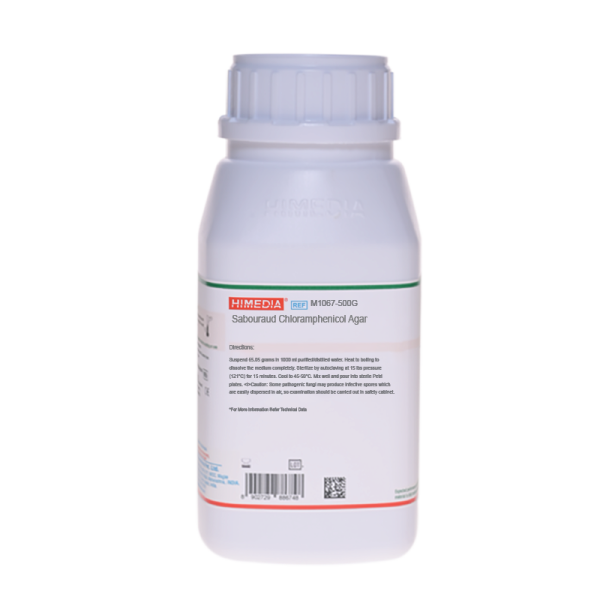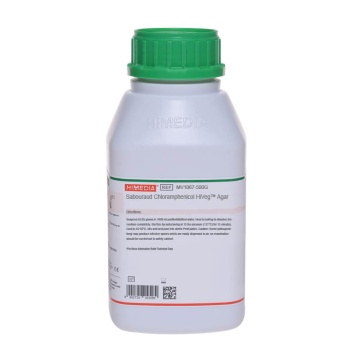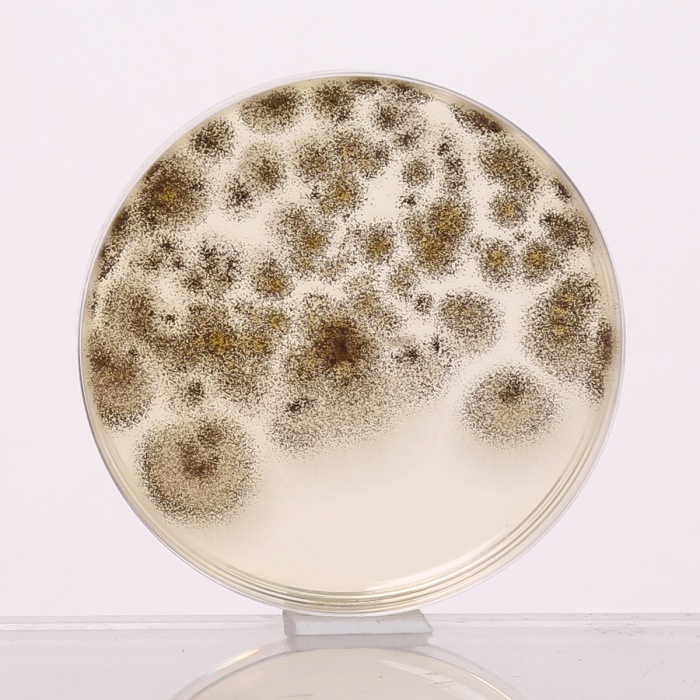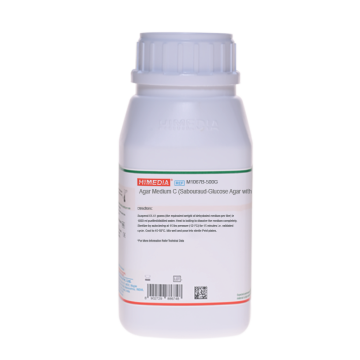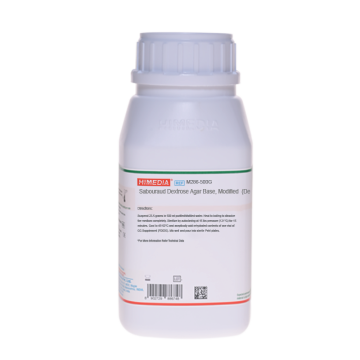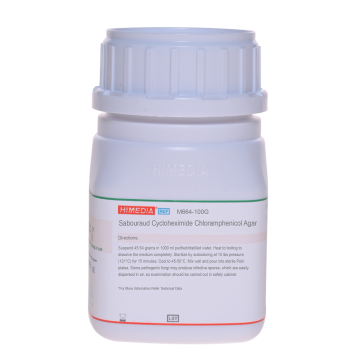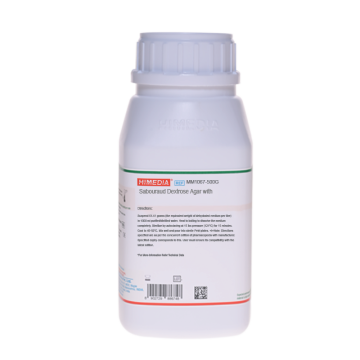 Your enquiry has been submitted
Your enquiry has been submitted
Sabouraud Chloramphenicol Agar
Intended use
For the selective cultivation of yeasts and moulds from clinical and non-clinical samples.
Composition**
| Ingredients | g/L |
|---|---|
| Tryptone | 5.000 |
| Peptone | 5.000 |
| Dextrose (Glucose) | 40.000 |
| Chloramphenicol | 0.050 |
| Agar | 15.000 |
| Final pH (at 25°C) | 5.6±0.2 |
**Formula adjusted, standardized to suit performance parameters
Directions
Suspend 65.05 grams in 1000 ml purified / distilled water. Heat to boiling to dissolve the medium completely. Sterilize by autoclaving at 15 lbs pressure (121°C) for 15 minutes. Cool to 45-50°C. Mix well and pour into sterile Petri plates.
Caution: Some pathogenic fungi may produce infective spores which are easily dispersed in air, so examination should be carried out in safety cabinet.
Principle And Interpretation
Sabouraud Chloramphenicol Agar is cited as Medium C and recommended for cultivation of yeasts and moulds. This medium was described originally by Sabouraud (1) for the cultivation of fungi, particularly useful for the fungi associated with skin infections. The medium is often used with antibiotics such as Chloramphenicol (2) for the isolation of pathogenic fungi from materials containing large numbers of fungi or bacteria.
Tryptone and peptone provide nitrogenous and carbonaceous compounds, long chain amino acids, and other essential growth nutrients. Dextrose provides an energy source. Chloramphenicol inhibits a wide range of Gram-positive and Gram-negative bacteria which makes the medium selective for fungi (3). The low pH favors fungal growth and inhibits contaminating bacteria from clinical specimens (4).
Type of specimen
Clinical samples - skin scrapings, nail scrapings; Food and dairy samples.
Specimen Collection and Handling:
For clinical samples follow appropriate techniques for handling specimens as per established guidelines (5,6). For food and dairy samples, follow appropriate techniques for sample collection and processing as per guidelines (7,8,9). After use, contaminated materials must be sterilized by autoclaving before discarding.
Warning and Precautions :
In Vitro diagnostic Use. For professional use only. Read the label before opening the container. Wear protective gloves/protective clothing/eye protection/ face protection. Follow good microbiological lab practices while handling specimens and culture. Standard precautions as per established guidelines should be followed while handling clinical specimens. Safety guidelines may be referred in individual safety data sheets.
Limitations :
- 1. Certain pathogenic fungi may show poor growth on this medium.
- 2. Presence of chloramphenicol may inhibit certain pathogenic fungi.
- 3. Overheating of the medium may result in low productivity and softening of gel.
Performance and Evaluation
Performance of the medium is expected when used as per the direction on the label within the expiry period when stored at recommended temperature.
Quality Control
Appearance Cream to yellow homogeneous free flowing powder.
Gelling Firm, comparable with 1.5% Agar gel
Colour and Clarity of prepared medium Light amber coloured clear to slightly opalescent gel forms in Petri plates
Reaction Reaction of 6.5% w/v aqueous solution at 25°C. pH: 5.6±0.2
pH 5.40-5.80
Cultural Response
Cultural characteristics observed after an incubation at 20-25°C for 48-72 hours (Incubate for 7 days for Trichophyton species).
| Organism | Inoculum (CFU) | Growth | Recovery |
|---|---|---|---|
| #Aspergillus brasiliensis ATCC 16404 (00053*) | 50-100 | good-luxuriant | |
| Candida albicans ATCC 10231 (00054*) | 50-100 | good-luxuriant | >=50% |
| Escherichia coli ATCC 25922 (00013*) | >=104 | inhibited | 0% |
| **Lactobacillus paracasei ATCC 334 | >=104 | inhibited | 0% |
| Saccharomyces cerevisiae ATCC 9763 (00058*) | 50-100 | good-luxuriant | >=50% |
| Trichophyton rubrum ATCC 28191 | 50-100 | good-luxuriant | |
| Escherichia coli ATCC 8739 (00012*) | >=104 | inhibited | 0% |
Key: *Corresponding WDCM numbers #Formerly known as Aspergillus niger.
**Formerly known as Lactobacillus casei
Storage and Shelf Life
Store the dehydrated powder and prepared medium on receipt between 15-25°C in a tightly closed container. Use before expiry date on the label. On opening, product should be properly stored dry, after tightly capping the bottle in order to prevent lump formation due to the hygroscopic nature of the product. Improper storage of the product may lead to lump formation. Store in dry ventilated area protected from extremes of temperature and sources of ignition Seal the container tightly after use.
Product performance is best if used within stated expiry period.
Disposal
User must ensure safe disposal by autoclaving and/or incineration of used or unusable preparations of this product. Follow established laboratory procedures in disposing of infectious materials and material that comes into contact with clinical sample must be decontaminated and disposed of in accordance with current laboratory techniques (5,6).
Reference
- 1.Sabouraud K., 1892, Ann. Dermatol. Syphilol, 3:1061.
- 2.Ajello L., 1957, J. Chron. Dis., 5:545.
- 3.Lorian (Ed.), 1980, Antibiotics In Laboratory Medicine, Williams and Wilkins, Baltimore.
- 4.Murray, P. R 2005, In Manual of Clinical Microbiology, 7th ed., ASM, Washington, D.C.
- 5.Isenberg, H.D. Clinical Microbiology Procedures Handbook. 2nd Edition.
- 6.Jorgensen, J.H., Pfaller, M.A., Carroll, K.C., Funke, G., Landry, M.L., Richter, S.S and Warnock., D.W. (2015) Manual of Clinical Microbiology, 11th Edition. Vol. 1.
- 7.American Public Health Association, Standard Methods for the Examination of Dairy Products, 1978, 14th Ed., Washington D.C.
- 8.Salfinger Y., and Tortorello M.L. Fifth (Ed.), 2015, Compendium of Methods for the Microbiological Examination of Foods, American Public Health Association, Washington, D.C.
- 9.Wehr H. M. and Frank J. H., 2004, Standard Methods for the Microbiological Examination of Dairy Products, 17th Ed., APHA Inc., Washington, D.C.
| Product Name | Sabouraud Chloramphenicol Agar |
|---|---|
| SKU | M1067 |
| Product Type | Regular |
| Physical Form | Powder |
| Origin | Animal |
| Packaging type | HDPE |
| References | 1. Sabouraud K., 1892, Ann. Dermatol. Syphilol, 3:1061. |
| Customized Product Available | No |



